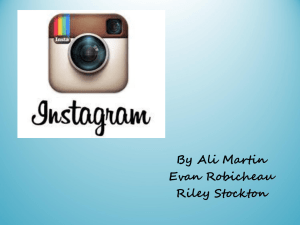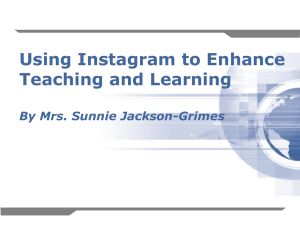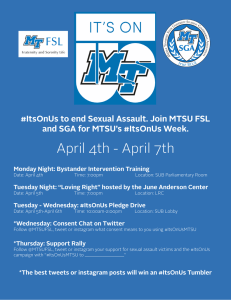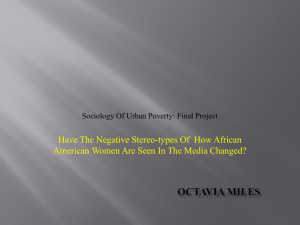What We Instagram: A First Analysis of Printing: Motivation
advertisement
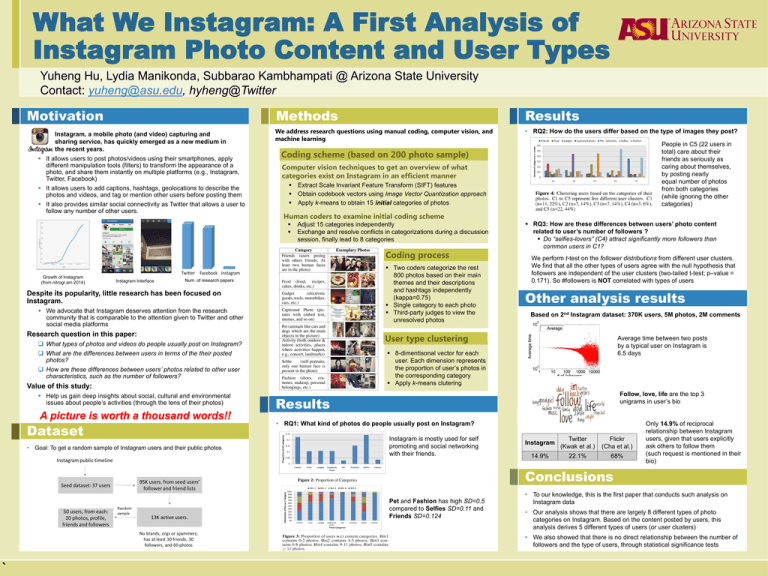
What We Instagram: A First Analysis of Instagram Photo Content and User Types Yuheng Hu, Lydia Manikonda, Subbarao Kambhampati @ Arizona State University Contact: yuheng@asu.edu, hyheng@Twitter Motivation Instagram, a mobile photo (and video) capturing and sharing service, has quickly emerged as a new medium in the recent years. It allows users to post photos/videos using their smartphones, apply different manipulation tools (filters) to transform the appearance of a photo, and share them instantly on multiple platforms (e.g., Instagram, Twitter, Facebook) It allows users to add captions, hashtags, geolocations to describe the photos and videos, and tag or mention other users before posting them It also provides similar social connectivity as Twitter that allows a user to follow any number of other users. Methods Results We address research questions using manual coding, computer vision, and machine learning • RQ2: How do the users differ based on the type of images they post? Coding scheme (based on 200 photo sample) Computer vision techniques to get an overview of what categories exist on Instagram in an efficient manner Extract Scale Invariant Feature Transform (SIFT) features Obtain codebook vectors using Image Vector Quantization approach Apply k-means to obtain 15 initial categories of photos Human coders to examine initial coding scheme Adjust 15 categories independently Exchange and resolve conflicts in categorizations during a discussion session, finally lead to 8 categories Coding process Growth of Instagram (from nitrogr.am 2014) Instagram Interface Two coders categorize the rest 800 photos based on their main themes and their descriptions and hashtags independently (kappa=0.75) Single category to each photo Third-party judges to view the unresolved photos Num. of research papers Despite its popularity, little research has been focused on Instagram. We advocate that Instagram deserves attention from the research community that is comparable to the attention given to Twitter and other social media platforms Research question in this paper: How are these differences between users’ photos related to other user characteristics, such as the number of followers? Value of this study: Dataset • Goal: To get a random sample of Instagram users and their public photos We perform t-test on the follower distributions from different user clusters. We find that all the other types of users agree with the null hypothesis that followers are independent of the user clusters (two-tailed t-test; p–value = 0.171). So #followers is NOT correlated with types of users Other analysis results Based on 2nd Instagram dataset: 370K users, 5M photos, 2M comments Average time between two posts by a typical user on Instagram is 6.5 days 8-dimentisonal vector for each user. Each dimension represents the proportion of user’s photos in the corresponding category Apply k-means clutering What are the differences between users in terms of the their posted photos? A picture is worth a thousand words!! RQ3: How are these differences between users’ photo content related to user’s number of followers ? Do “selfies-lovers” (C4) attract significantly more followers than common users in C1? User type clustering What types of photos and videos do people usually post on Instagram? Help us gain deep insights about social, cultural and environmental issues about people’s activities (through the lens of their photos) People in C5 (22 users in total) care about their friends as seriously as caring about themselves, by posting nearly equal number of photos from both categories (while ignoring the other categories) Follow, love, life are the top 3 unigrams in user’s bio Results • RQ1: What kind of photos do people usually post on Instagram? Instagram is mostly used for self promoting and social networking with their friends. Twitter Instagram (Kwak et al.) 14.9% 22.1% Flickr (Cha et al.) 68% Only 14.9% of reciprocal relationship between Instagram users, given that users explicitly ask others to follow them (such request is mentioned in their bio) Conclusions Pet and Fashion has high SD=0.5 compared to Selfies SD=0.11 and Friends SD=0.124 • To our knowledge, this is the first paper that conducts such analysis on Instagram data • Our analysis shows that there are largely 8 different types of photo categories on Instagram. Based on the content posted by users, this analysis derives 5 different types of users (or user clusters) • We also showed that there is no direct relationship between the number of followers and the type of users, through statistical significance tests `
